1997 CHEVROLET BLAZER light
[x] Cancel search: lightPage 168 of 402
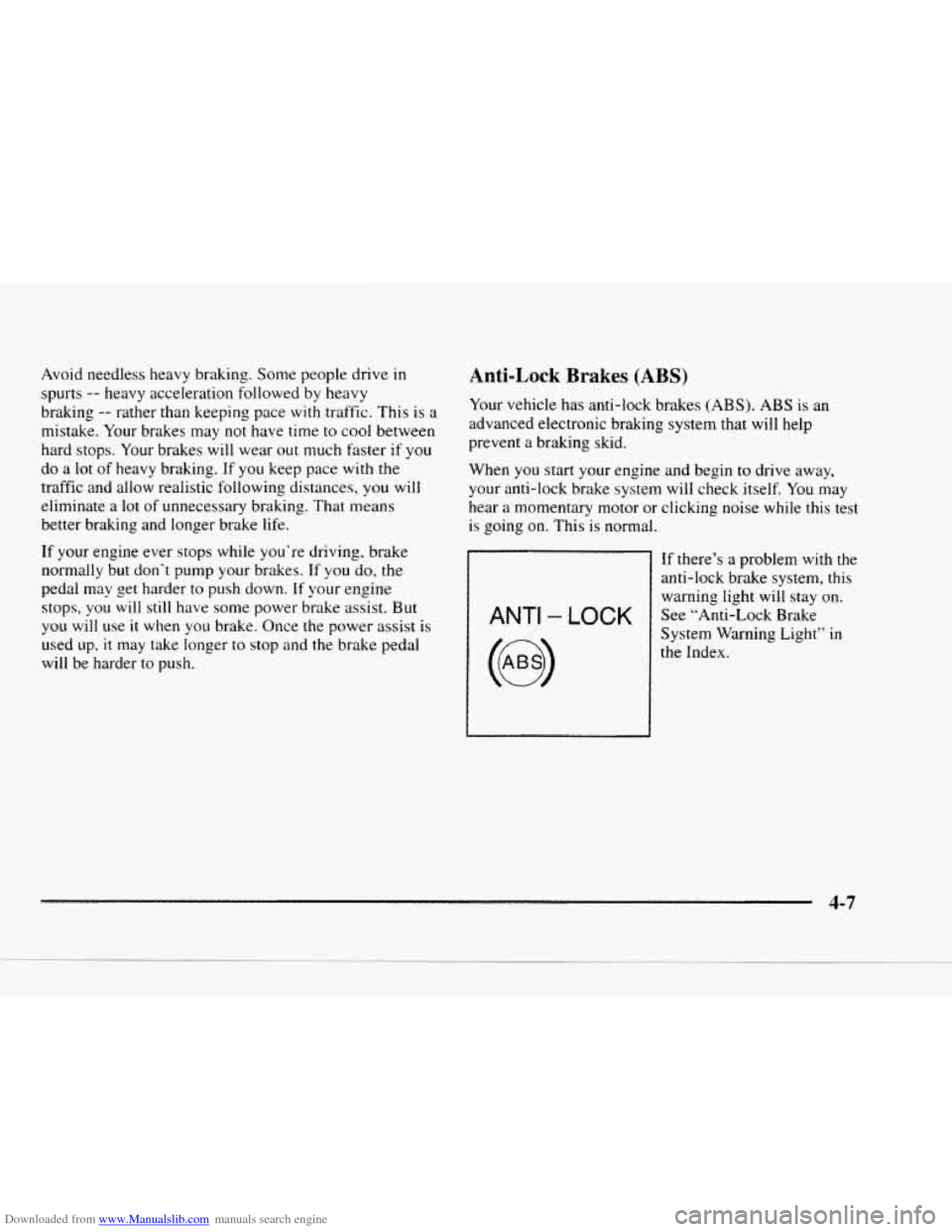
Downloaded from www.Manualslib.com manuals search engine Avoid needless heavy braking. Some people drive in
spurts
-- heavy acceleration followed by heavy
braking
-- rather than keeping pace with traffic. This is a
mistake. Your brakes may not have time to cool between
hard stops. Your brakes
will wear out much faster if you
do a lot of heavy braking. If you keep pace with the
traffic and allow realistic following distances,
you will
eliminate a
lot of unnecessary braking. That means
better braking and longer brake
life.
If your engine ever stops while you‘re driving, brake
normally but don’t
pump your brakes. If you do, the
pedal may get harder
to push down. If your engine
stops,
you will still have some power brake assist. But
you will
use it when you brake. Once the power assist is
used up, it may take longer to stop and the brake pedal
will be harder
to push.
Anti-Lock Brakes (ABS)
Your vehicle has anti-lock brakes (ABS). ABS is an
advanced electronic braking system that will help
prevent a braking skid.
When
you start your engine and begin to drive away,
your anti-lock brake system will check itself.
You may
hear a momentary motor or clicking noise while this test
is going on. This is normal.
ANTI - LOCK
If there’s a problem with the
anti-lock brake system, this
warning light will stay
on.
See “Anti-Lock Brake
System Warning Light”
in
the Index.
-. 4-7
Page 172 of 402
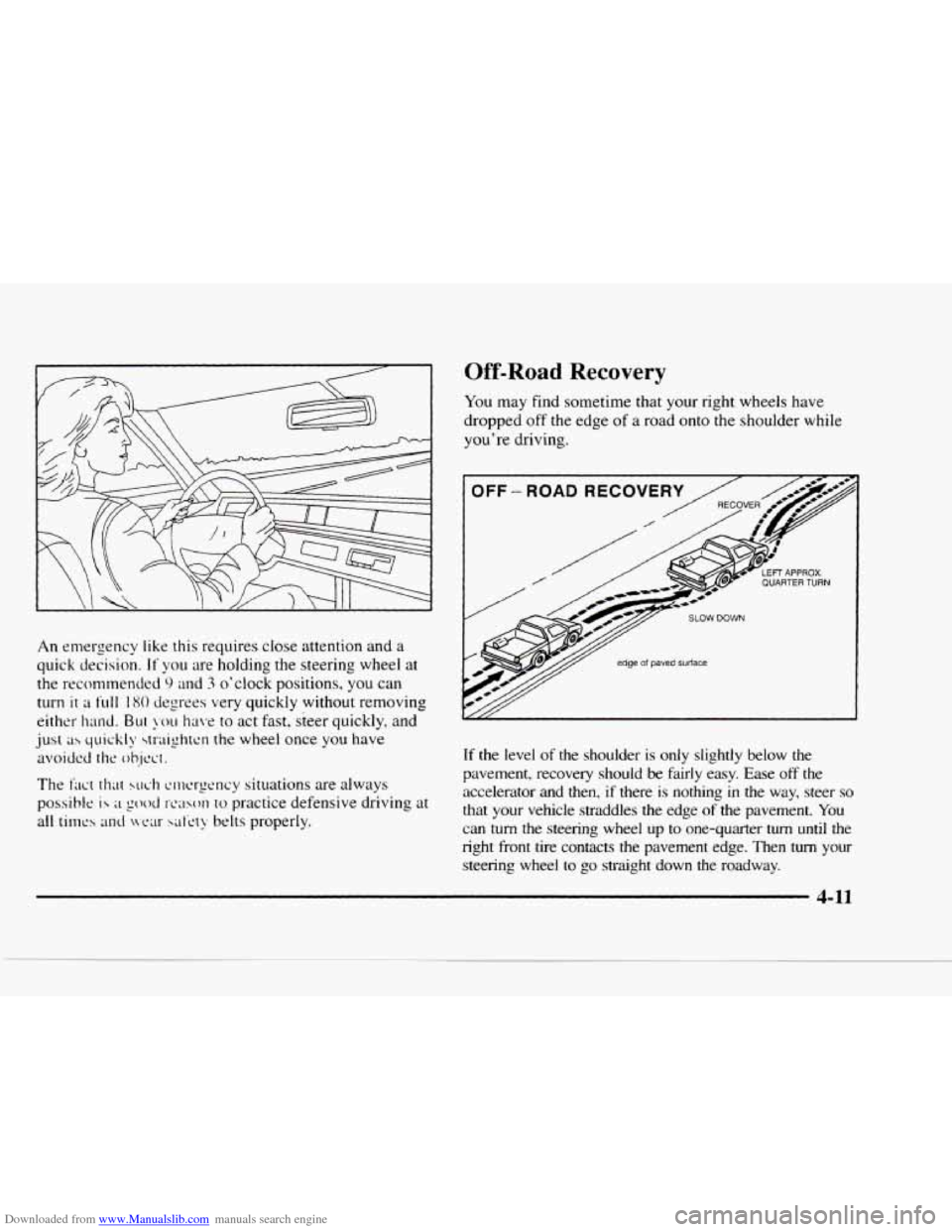
Downloaded from www.Manualslib.com manuals search engine An emergency like this requires close attention and a
quick decision. If you are holding the steering wheel at
the recommended
9 and 3 o'clock positions, you can
turn
it a tull 180 degrees very quickly without removing
either
hand. Bur you hrt\*e to act fast, steer quickly, and
just ah quickly straighten the wheel once you have
avoided
the ob-jcct.
The fact that wch clncrgcncy situations are always
possible ih ;I good reason to practice defensive driving at
all
times and NYN satety belts properly.
Off-Road Recovery
You may find sometime that your right wheels have
dropped off
the edge of a road onto the shoulder while
you're driving.
I OFF - ROA
v/// edge of paved surface
If the level of the shoulder is only slightly below the
pavement, recovery should be
fairly easy. Ease off the
accelerator and then, if there is nothing in the way, steer so
that your vehicle straddles the edge of the pavement. You
can turn the steering wheel up to one-quarter turn until the
right front tire contacts the pavement
edge. Then turn your
steering wheel to go straight down the roadway.
4-11
Page 179 of 402
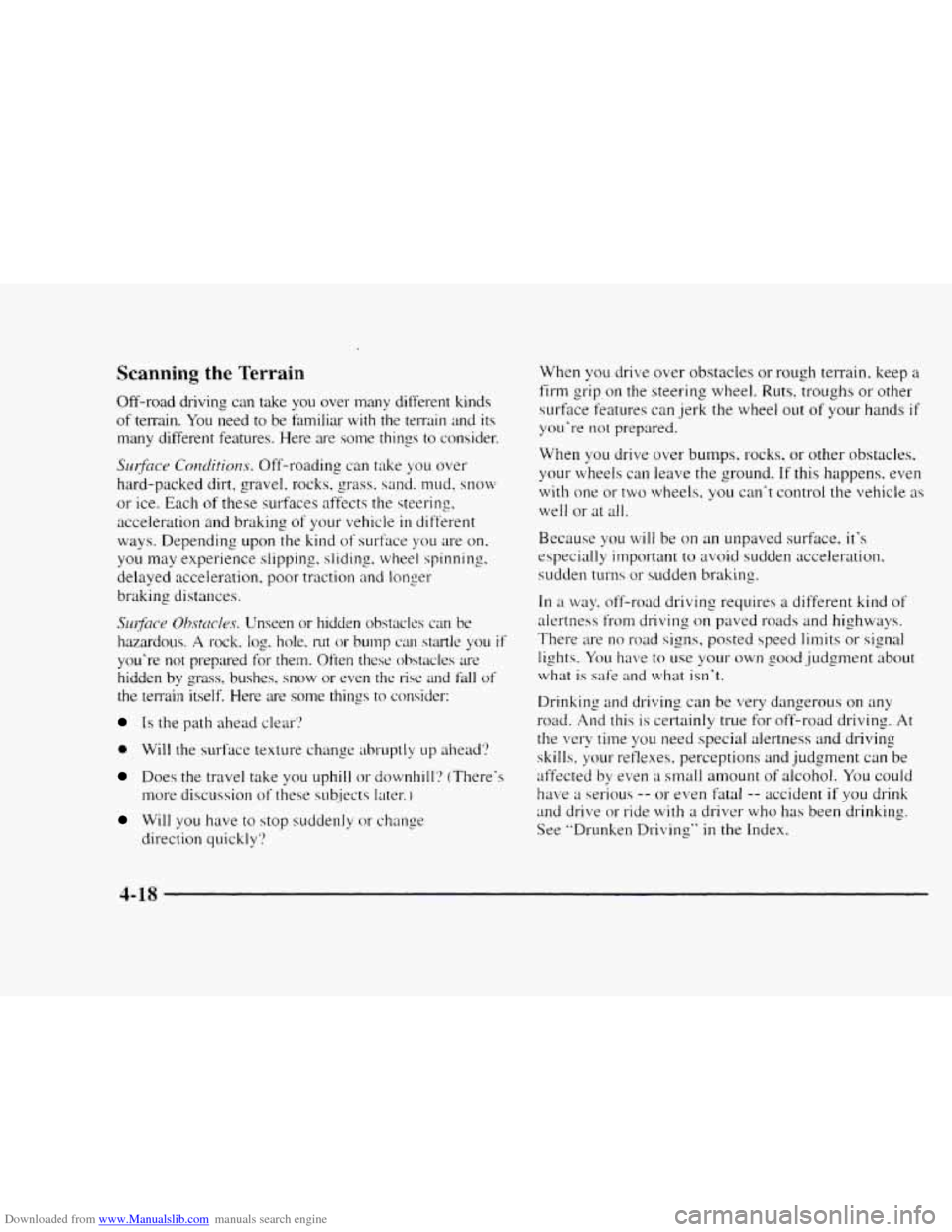
Downloaded from www.Manualslib.com manuals search engine Scanning the Terrain
Off-road driving can take you over mLmy different kinds
of terrain.
You need to be fatniliar with the terrain and its
many different features.
Here are some things to consider.
Surface Cmditiom. Off-roading can take you over
hard-packed dirt, gravel. rocks. grass. sand, mud, snow
or ice. Each
of these surfaces affects the steering,
acceleration and brakinz
of your vehicle in different
ways. Depending upon the kind of surfxe you are on.
you may experience slipping. sliding. wheel spinning.
delayed acceieration, poor traction and longer
braking distances.
Sru-fnce 0hstcrcle.v. Unseen or hidden obstacles can be
hazardous.
A rock. log hole. rut or bump CUI startle you if
you're not prepared for them. Often these obstacles are
hidden
by grass, bushes. snow or even the rise and fall of
the terrain itself. Here are some things to consider:
Is the path ahead clear'?
0 Will the surface texture change abruptly up ahead'?
Does the travel take you uphill or downhill'? (There's
more discussion
of these sub-jects later.)
Will you have to stop suddenly or change
direction quicklv'? When
you drive
over obstacles or rough terrain, keep a
firm grip on the steering wheel. Ruts, troughs or other
surface features can jerk the wheel out of
your hands if
you're not prepared.
When
you drive over bumps. rocks, or other obstacles,
your wheels can leave
the ground. If this happens. even
with one or two wheels, you can't control the vehicle as
well or at all.
Because you
will be on an unpaved surface. it's
especially important to avoid sudden acceleration.
sudden
turns or sudden braking.
In a way, off-road driving requires a different kind of
alertness from driving on paved roads and highways.
There are
no road signs. posted speed limits or signal
lights. You have to
use your own good judgment about
what is
safe and what isn't.
Drinking and driving can be very dangerous on any
road.
And this is certainty true for off-road driving. At
the very time you need special alertness and driving
skills, your reflexes. perceptions and judgment can be
affected
by even z1 small amount of alcohol. You could
have a serious -- or even fatal -- accident if you drink
and drive or ride with a driver who has been drinking.
See "Drunken Driving" in the index.
4-18
Page 184 of 402
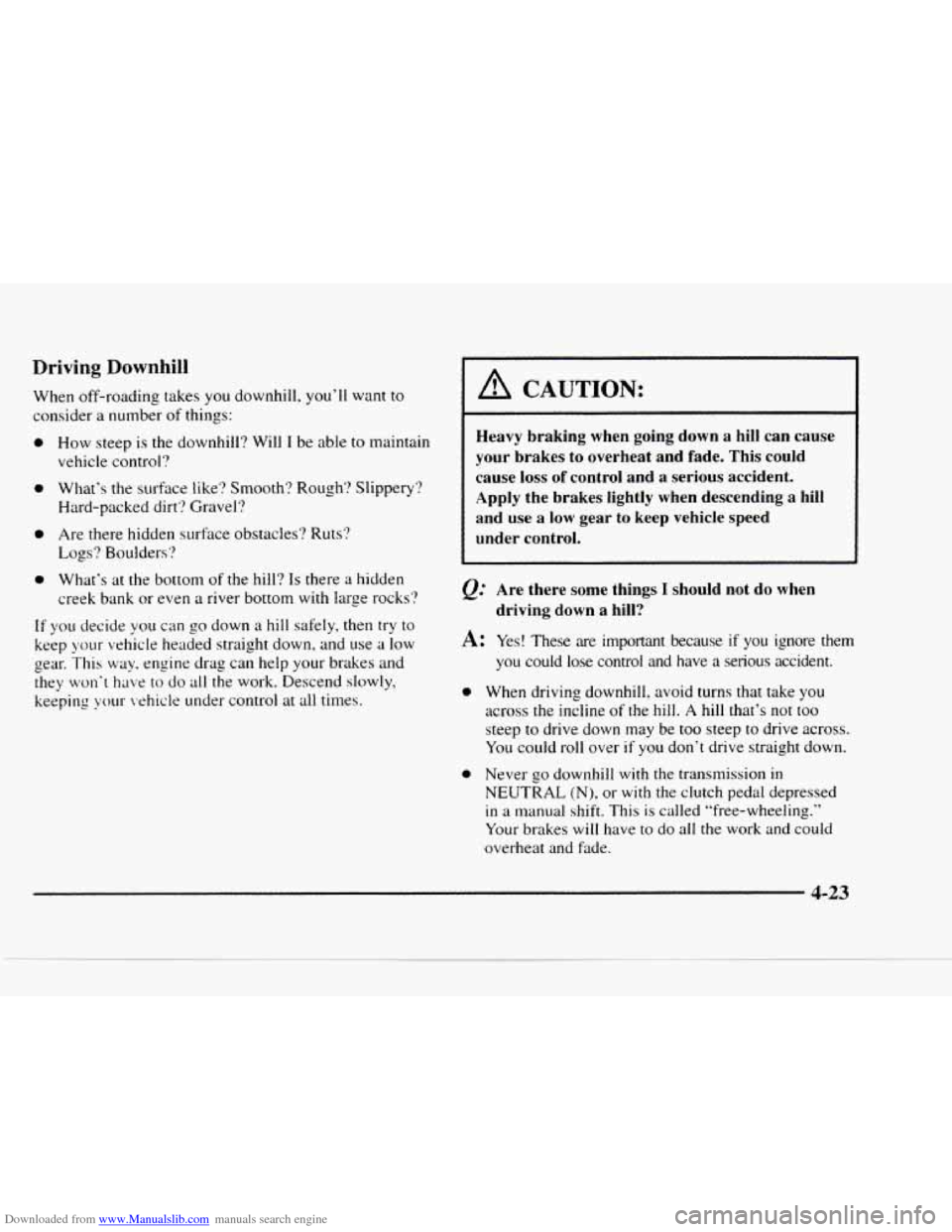
Downloaded from www.Manualslib.com manuals search engine Driving Downhill
When off-roading takes you downhill, you’ll want to
consider a number of things:
0 How steep is the downhill? Will I be able to maintain
vehicle control?
0 What’s the surface like? Smooth? Rough‘? Slippery‘?
Hard-pac ked dirt
‘? Gravel?
0 Are there hidden surface obstacles? Ruts’?
Logs? Boulders’?
0 What’s at the bottom of the hill? Is there a hidden
creek bank or even
a river bottom with large rocks?
If you decide you can go down a hill safely, then try to
keep your vehicle headed straight down, and use a low
gear. This
way. engine drag can help your brakes and
they
won‘t have to do all the work. Descend slowly,
keeping
y)ur
ehick under control at all times.
I A CAUTION:
1 I
Heavy braking when going aown a hill can cause
your brakes
to overheat and fade. This could
cause
loss of control and a serious accident.
Apply the brakes lightly when descending a hill
and use
a low gear to keep vehicle speed
under control.
&= Are there some things I should not do when
driving down a
hill?
A: Yes! These are important because if you ignore them
you could lose control and have a serious accident.
0 When driving downhill, avoid turns that take you
across the incline of the hill. A hill that’s not too
steep
to drive down may be too steep to drive across.
You could roll over if you don’t drive straight down.
NEUTRAL (N). or with the clutch pedal depressed
in a manual shift. This is called “free-wheeling.”
Your brakes will have
to do all the work and could
overheat and fade.
0 Never go downhill with the transmission in
4-23
Page 187 of 402
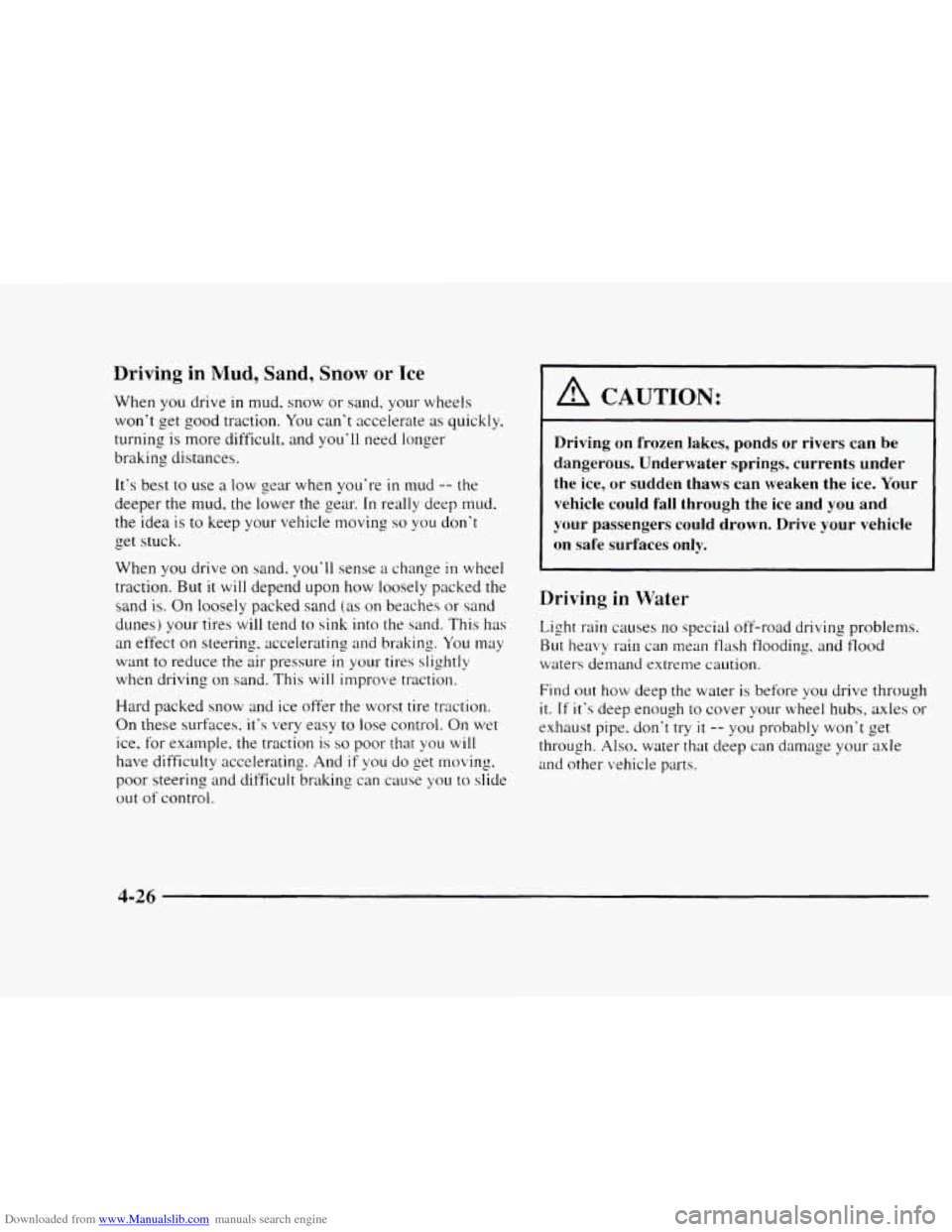
Downloaded from www.Manualslib.com manuals search engine Driving in Mud, Sand, Snow or Ice
When you drive in mud. snow or sand. your wheels
won't get good traction. You can't accelerate as quickly,
turning is more difficult. and you'll need longer
braking distances.
It's best
to use a low gear when you're in mud -- the
deeper the mud. the lower the gear.
In really deep mud.
the idea is
to keep your vehicle moving so you don't
b *et stuck.
When you drive on sand,
you'll sense a change in wheel
traction. But
it will depend upon how loosely packed the
sand is.
On loosely packed sand (as on beaches or sand
dunes) your tires will tend to
sink into the sand. This has
an effect on steering. accelerating and braking.
You may
want to reduce the air pressure in your tires slightly
when driving on sand. This
will improve traction.
Hard packed
snow and ice offer the worst tire traction.
On these surfaces,
it's very easy to lose control. On wet
ice,
for example. the traction is so poor that you will
have difficulty accelerating. And if you do get moving,
poor steering and difficult braking can
came you to slide
out
of control.
I A CAUTION:
Driving on frozen lakes, ponds or rivers can be
dangerous. Underwater springs. currents under
the ice, or sudden thaws can weaken the ice. Your
vehicle could fall through the
ice and you and
your passengers could drown. Drive your vehicle
on safe surfaces only.
Driving in Water
Light rain causes no special off-road driving problems.
But heavy rain can mean tlash flooding, and flood
waters demand extreme caution.
Find out
how deep the water is before you drive through
it. If it's deep enough to cover your wheel hubs, axles or
exhaust pipe. don't
try it -- you probably won't get
through. Also. water that deep can damage your axle
and other vehicle parts.
4-26
Page 189 of 402
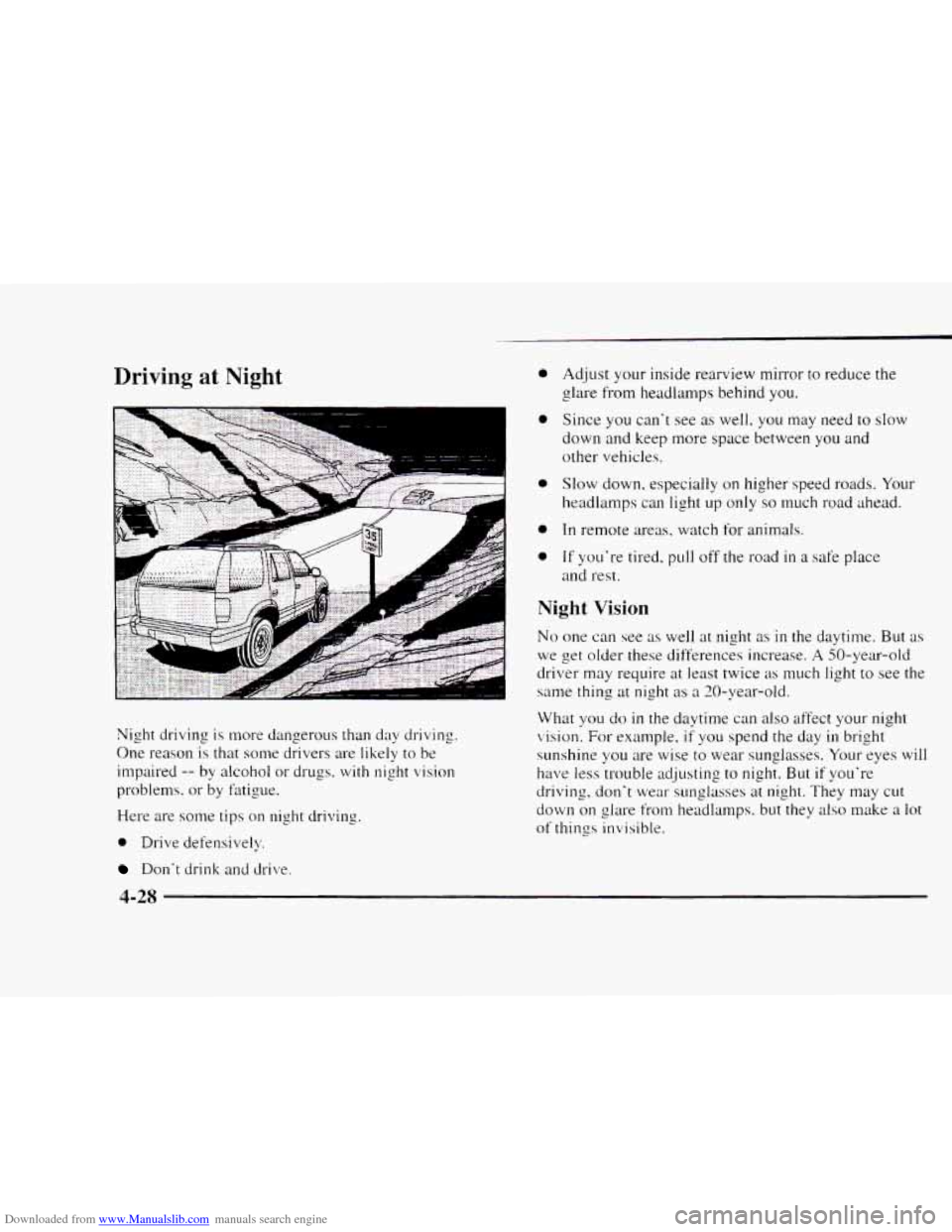
Downloaded from www.Manualslib.com manuals search engine Driving at Night a
0
0
a
0
Adjust your inside rearview mirror to reduce the
3 olare from headlamps behind you.
Since you can't see
as well, you may need to sIow
down and keep more space between you and
other vehicles.
Slow down, especially on higher speed roads. Your
headlamps
can light up only so much road ahead.
In remote areas, watch for animals.
If you're tired, pull off the road in a safe place
and rest.
k- ---I
Night Vision
No one can see as well at night as in the daytime. But as
we get older these differences increase. A 50-year-old
driver may require at least twice
as much light to see the
same thing at
night as a 20-year-old.
Night driving is more dangerous than
day driving.
One reason is that some drivers are likely to
be
impaired -- by alcohol or drugs. with night vision
problems. or by htigue.
Here are some tips on
night driving.
0 Drive defensively. What
you do
in the daytime can also affect your night
vision. For example. if you spend the day in bright
sunshine you are wise to wear sunglasses. Your eyes
will
have less trouble adjusting to night. But if you're
driving, don't wear sunglasses at night. They
may cut
down on glare from headlamps, but they also make
a lot
of things invisible.
Don't drink and drive
4-28
Page 190 of 402
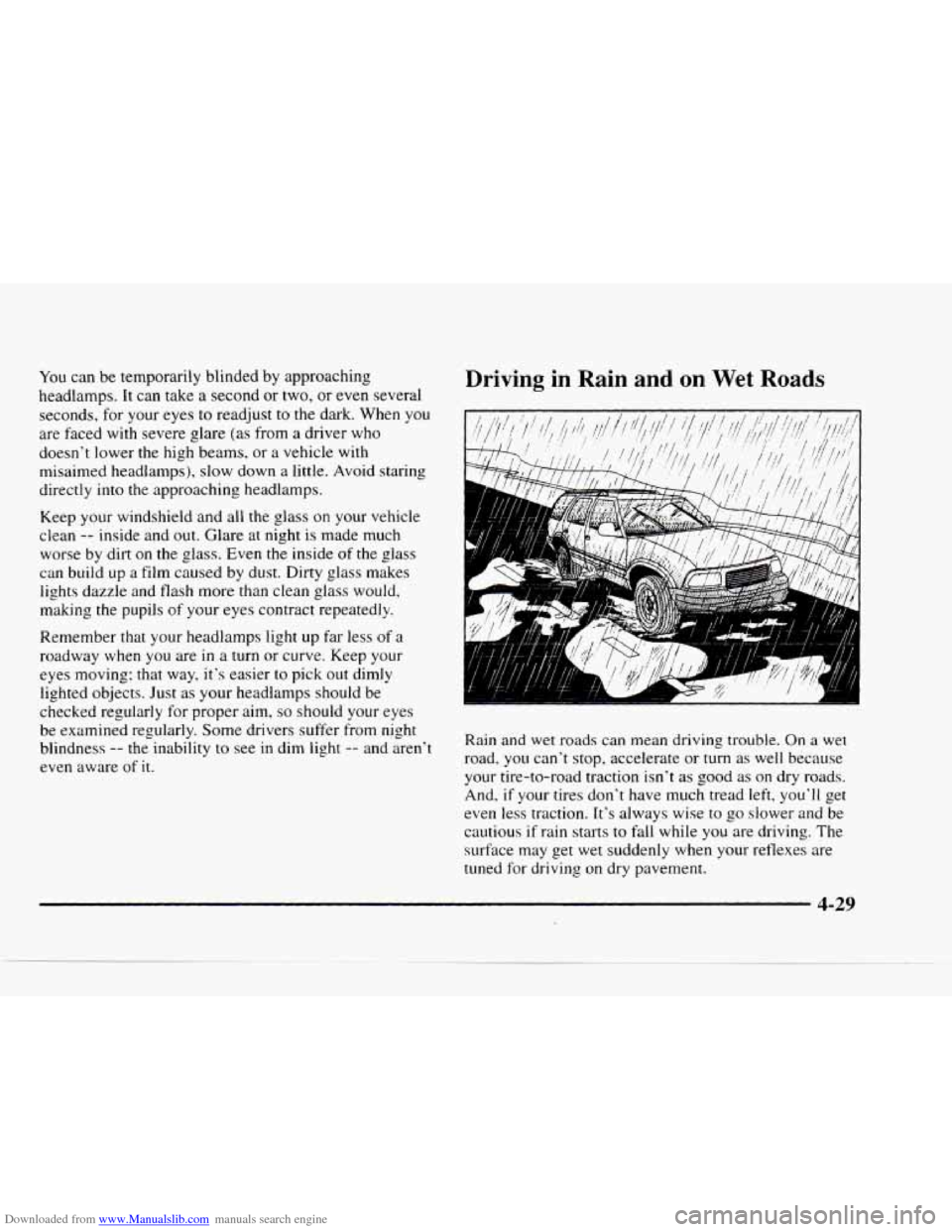
Downloaded from www.Manualslib.com manuals search engine You can be temporarily blinded by approaching
headlamps. It can take a second or two, or even several
seconds, for your eyes
to readjust to the dark. When you
are faced with severe glare
(as from a driver who
doesn’t lower the high beams, or a vehicle with
misaimed headlamps), slow down
a little. Avoid staring
directly
into the approaching headlamps.
Keep your windshield and all the glass
on your vehicle
clean
-- inside and out. Glare at night is made much
worse by dirt on
the glass. Even the inside of the glass
can build up
a film caused by dust. Dirty glass makes
lights dazzle and flash more than clean glass would,
making the pupils
of your eyes contract repeatedly.
Remember that your headlamps light
up far less of a
roadway when you are in a turn or curve. Keep your
eyes moving: that way, it’s easier
to pick out dimly
lighted objects. Just as your headlamps should be
checked regularly for proper aim,
so should your eyes
be examined regularly. Some drivers suffer from night
blindness
-- the inability to see in dim light -- and aren‘t
even aware
of it.
Driving in Rain and on Wet Roads
U
Rain and wet roads can mean driving trouble. On a wet
road, you can’t stop, accelerate or turn as well because
your tire-to-road traction isn’t as good as
on dry roads.
And,
if your tires don’t have much tread left, you’ll get
even less traction.
It’s always wise to go slower and be
cautious if rain starts to fall while you are driving. The
surface may get wet suddenly when your reflexes are
tuned for driving on dry pavement.
4-29
Page 191 of 402
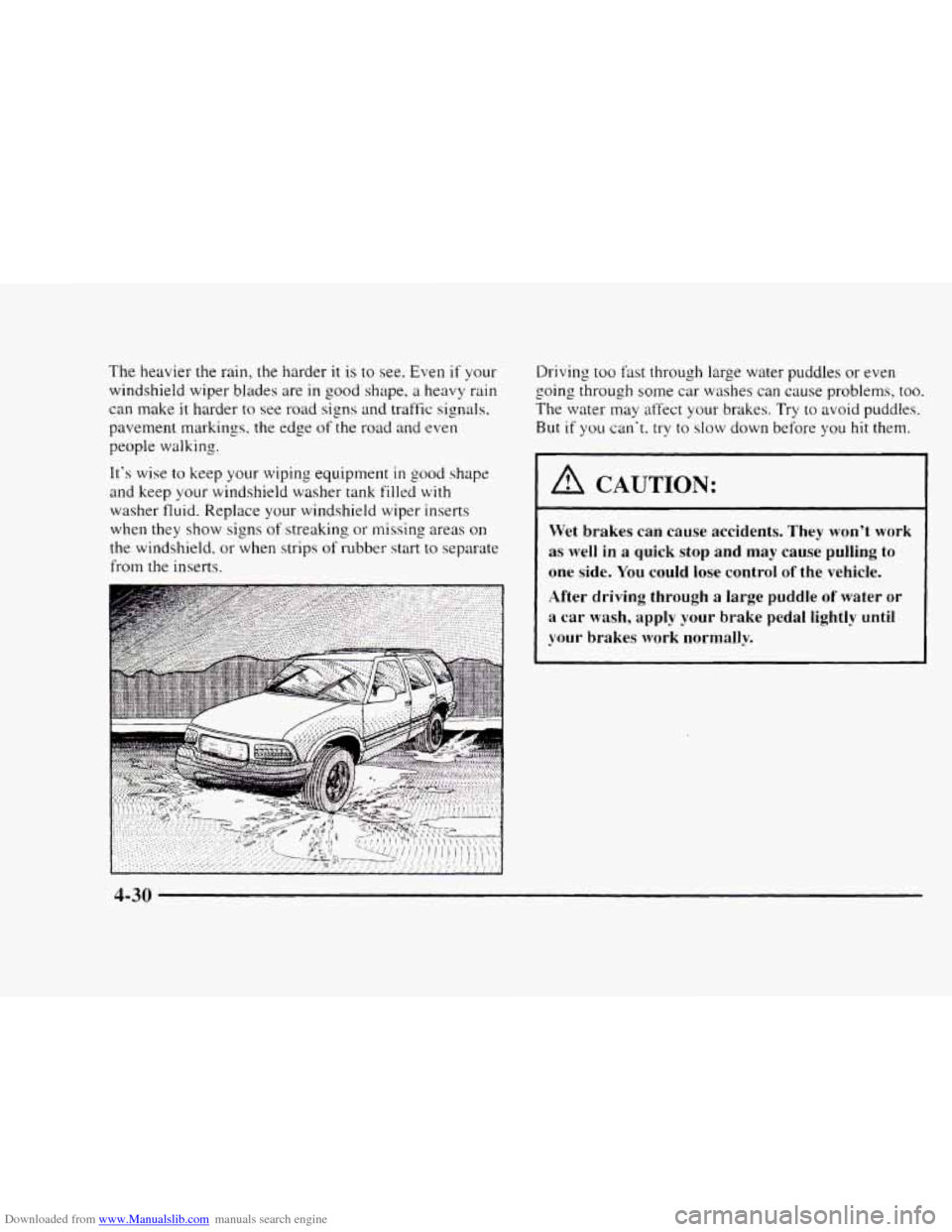
Downloaded from www.Manualslib.com manuals search engine The heavier the rain, the harder it is to see. Even if your
windshield wiper blades are
in good shape, a heavy rain
can make
it harder to see road signs and traffic sipals.
pavement markings. the edge
of the road and even
people walking.
It's wise to keep
your wiping equipment in good shape
and keep your windshield washer tank filled
with
washer fluid. Replace your windshield wiper inserts
when they show signs
of streaking or missing areas on
the windshield, or when strips of rubber start to separate
from the inserts. Driving
too
fast through large water puddles or even
going through
some car washes can cause problems, too.
The water may affect your brakes. Try to avoid puddles.
But if you can't. try to slow down before you hit them.
I A CAUTION:
Wet brakes can cause accidents. They won't work
as
well in a quick stop and may cause pulling to
one side. You could lose control
of the vehicle.
After driving through
a large puddle of water or
a car wash, apply your brake pedal lightly until
your brakes work normally.
4-30